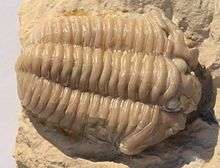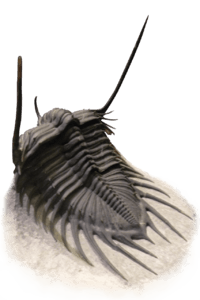Calymene
| Calymene | |
|---|---|
 | |
| Calymene clavicula 32mm, Henryhouse Formation, Oklahoma, Cayugan | |
| Scientific classification | |
| Kingdom: | Animalia |
| Phylum: | Arthropoda |
| Class: | †[Trilobita]] |
| Order: | †Phacopida |
| Family: | †Calymenidae |
| Genus: | †Calymene Brongniart, 1822 |
| Type species | |
| Calymene blumenbachii Brongniart in Desmarest, 1817 [1] | |
Calymene (meaning beautiful crescent as a reference to the glabella) is a genus of trilobites in the order Phacopida that are found throughout North America, North Africa, and Europe in primarily Silurian outcrops.[2] Calymene is closely related to Flexicalymene, and both genera are frequently found enrolled.[3] Calymene trilobites are small, typically 2 cm in length. The cephalon is the widest part of the animal and the thorax usually has 13 segments.[4]
The correct genus authorship is Brongniart (1822).[5] A previously published genus description in Desmarest (1816)[6] (often mis-cited as "Calymena" Desmarest, 1817) was suppressed by ICZN Opinion 1433.
Known species and locations
- †Calymene breviceps, Indiana and Illinois
- †Calymene blumenbachiii, Dudley, England[1]
- †Calymene brevicapitata, N. and S. Wales
- †Calymene cambrensis, Wales
- †Calymene celebra, Illinois, Indiana, and Wisconsin.[7][8]
- †Calymene clavicula, Oklahoma
- †Calymene daviesii, Radnorshire, Wales
- †Calymene duplicata, Wales and Ireland
- †Calymene hopkinsoni, Wales
- †Calymene niagarensis, New York
- †Calymene parvifrons, Wales
- †Calymene senaria, N. Wales and Ireland
- †Calymene tristani, Cornwall, England
- †Calymene tuberculata, Gotland, Sweden
- †Calymene vogdesi, Ohio
- †Calymene sp. in the Silurian–Ordovician of Morocco
Reassigned species
Since the genus Calymene was established early on in paleontology, a number of species previously assigned to it have since been transferred to other genera:[9]
- C. aculeata = Parasolenopleura aculeata
- C. aequalis = Archegonus aequalis
- C. anchiops = Anchiopella anchiops
- C. arachnoides = Asteropyge arachnoides
- C. arago = Colpocoryphe arago
- C. articulata = Crotalocephalus articulatus
- C. baylei = Metacalymene baylei
- C. bellatula = Cybele bellatula
- C. bufo rana = Phacops rana
- C. calicephala = Orimops calicephala
- C. canaliculata = Solenopleura canaliculata[10]
- C. caractaci = Flexicalymene caractaci
- C. clavifrons = Cyrtometopus clavifrons
- C. concinna = Proetus concinnus
- C. diademata = Diacalymene diademata
- C. downingiae = Acaste downingiae
- C. frontiloba = Pliomera fischeri
- C. granulata = Phacops granulatus
- C. holometopa = Solenopleura holometopa[10]
- C. marginata = Perliproetus marginata
- C. odini = Chasmops odini
- C. ornata = Ceraurinella ornata[11]
- C. papillata = Papillicalymene papillata
- C. platycephala = Platycoryphe platycephala
- C. polytoma = Pliomera fischeri
- C. sclerops = Pterygometopus sclerops
- C. sinensis = Blackwelderia sinensis
- C. speciosa = Parapilekia speciosa
- C. stenometopa = Acrocephalites stenometopus
- C. stokesii = Phacopidae, generic assignment uncertain[12]
- C. tingi = Calymenesun tingi
- C. tournemini = Placoparia tournemini
- C. tristani = Synhomalonotus tristani
- C. unicornis = Reedocalymene unicornis
- C. variolaris = Balisoma variolaris
- C. verrucosa = Atractopyge verrucosa
- C. volborthi = Ptychometopus volborthi
References
- 1 2 Derek J. Siveter (1985). "The type species of Calymene (Trilobita) from the Silurian of Dudley, England" (PDF). Palaeontology. 28 (4): 783–792.
- ↑ "†Calymene Muenster 1840 (trilobite)". The Paleontology Database. Retrieved April 29, 2012.
- ↑ John P. Rafferty, ed. (2010). The Paleozoic Era: Diversification of Plant and Animal Life. Geologic History of Earth. Britannica Educational Publishing. ISBN 978-1-61530-196-6.
- ↑ Milson, C.; Rigby, S. (2004). Fossils at a Glance. Oxford: Blackwell Science Ltd.
- ↑ Brongniart, A. 1822. Les Trilobites. pp. 1-65, pls. 1-4 in: Histoire Naturelle des Crustacés Fossiles. Paris. F.-G. Levrault, Libraire. 154 pp. 11 pls.
- ↑ Desmarest, A-G. 1816. Calymène. pp. 49-50 in: Nouveau Dictionnaire d'Histoire Naturelle, Nouvelle Edition, Tome 5.
- ↑ "Calymene celebra Raymond 1916 (trilobite)". Paleobiology Database. Retrieved 20 August 2011.
- ↑ Alex J. Chestnut. "Using morphometrics, phylogenetic systematics and parsimony analysis to gain insight into the evolutionary affinities of the Calymenidae Trilobita". OhioLINK ETD Center. Retrieved August 21, 2011.
- ↑ Moore, R.C. (1959). Arthropoda I - Arthropoda General Features, Proarthropoda, Euarthropoda General Features, Trilobitomorpha. Treatise on Invertebrate Paleontology. Part O. Boulder, Colorado/Lawrence, Kansas: Geological Society of America/University of Kansas Press. pp. 1–560. ISBN 0-8137-3015-5.
- 1 2 Esteve, Jorge (2015). "Systematic revision of the genus Solenopleura Angelin, 1854, Ptychopariida, Trilobita, Cambrian Series 3". Annales de Paléontologie. 101: 185–192. doi:10.1016/j.annpal.2015.05.001.
- ↑ Pärnaste, Helje (2004). "Revision of the Ordovician cheirurid trilobite genus Reraspis with the description of the earliest representative" (PDF). Proc. Estonian Acad. Sci. Geol. 53 (2): 125–138.
- ↑ Ramskjöld, L.; Werdelin, L. (1991). "The phylogeny and evolution of some phacopid trilobites". Cladistics. 7: 29–74. doi:10.1111/j.1096-0031.1991.tb00021.x.
External links

- Henry Woodward (1877). A Catalogue of British Fossil Crustacea, with their Synonyms and the Range in Time of Each Genus and Order. Taylor and Francis. pp. 28–29.
